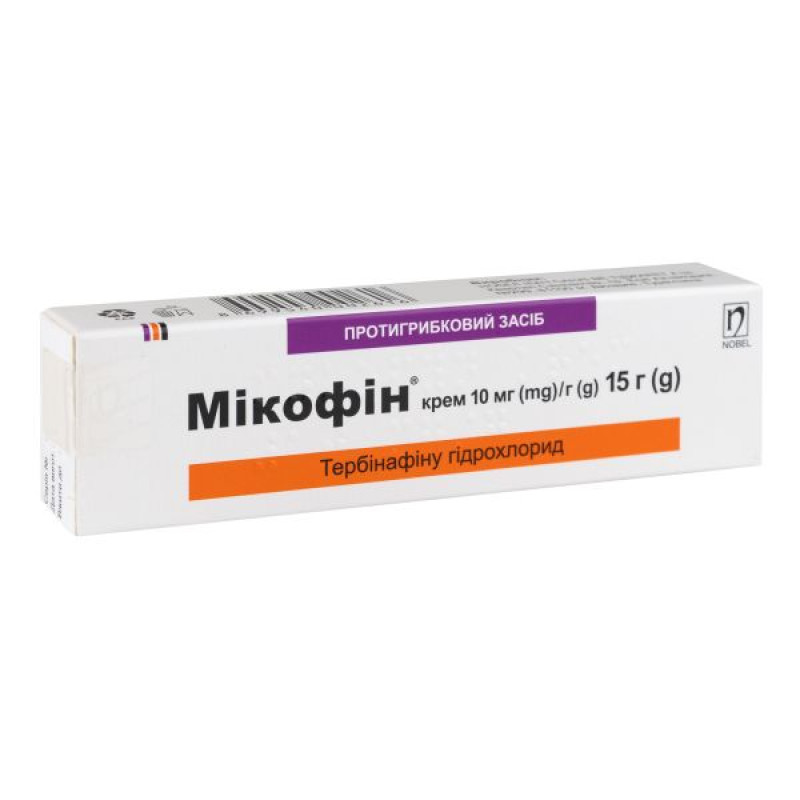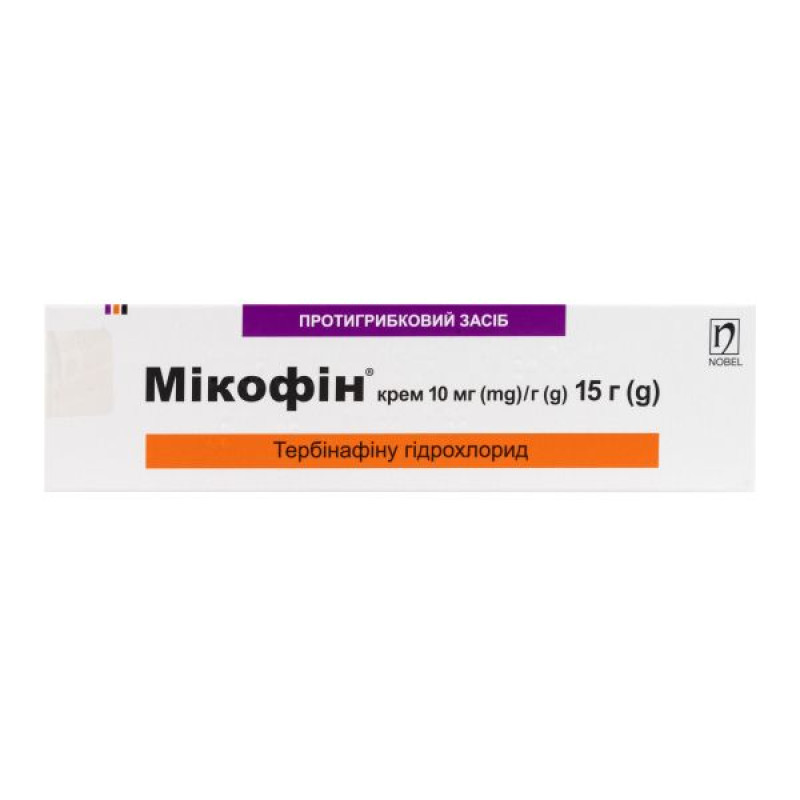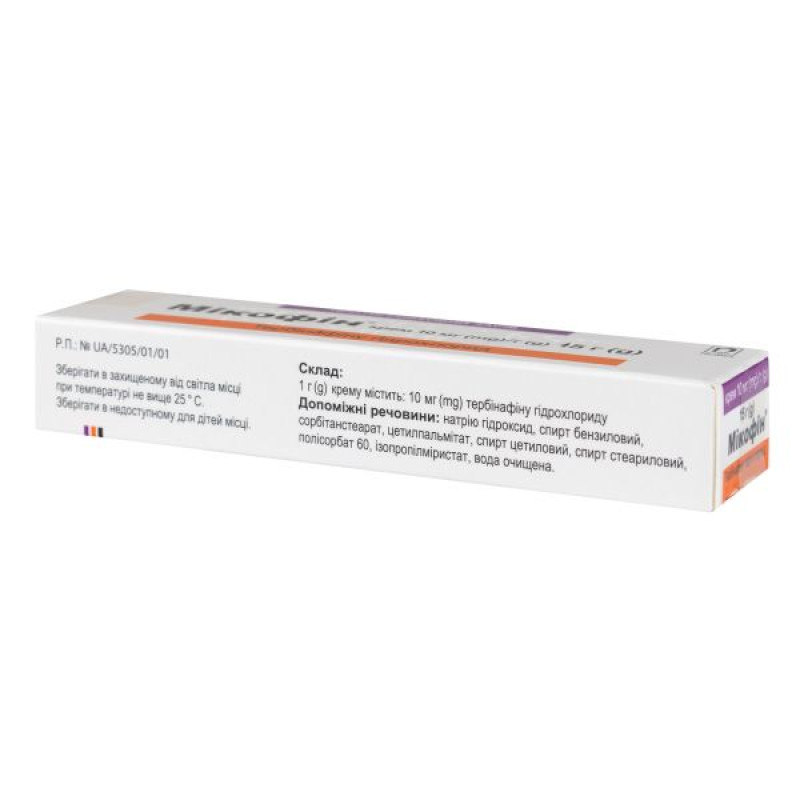Mycofin cream 1% tube 15 g

Pharmacological properties
Pharmacodynamics. Terbinafine is an active substance with a broad spectrum of antifungal activity. It is active against dermatophytes such as Trichophyton (T. rubrum, T. mentagrophytes, T. tonsurans, T. verrucosum, T. violaceum), Microsporum canis, Epidermophyton floccosum and yeast fungi of the genus Candida (Candida albicans) and Pityrosporum. In low concentrations, it has a fungicidal effect on dermatophytes, molds (Aspergillus, Cladosporium, Scopulariopsis brevicaulis, etc.) and some dimorphic fungi. The effect on yeast fungi of the genus Candida and its forms can be fungicidal or fungistatic, depending on the type of fungus. Terbinafine is also active against Pityrosporum - the causative agent of lichen variegated. Terbinafine disrupts the early stage of ergosterol biosynthesis in fungi by inhibiting the squalene epoxidase enzyme located in the fungal cell membrane. This enzyme does not belong to the cytochrome p450 system. This leads to ergosterol deficiency and intracellular accumulation of squalene, which causes fungal cell death. When taken orally, the drug accumulates in the skin, hair, and nails in concentrations that provide fungicidal action.
Pharmacokinetics. When administered orally, taking into account metabolism after the first pass through the liver, terbinafine is well absorbed (about 70%), bioavailability is 50%. Terbinafine binds well to blood plasma proteins (99%), quickly penetrates into subcutaneous fat and reaches high concentrations in hair follicles, hair, skin, subcutaneous tissue. It has been proven that terbinafine is distributed into the nail plates during the first weeks after the start of treatment.
Terbinafine is rapidly metabolized by at least 7 cytochrome P450 isoenzymes. It is biotransformed in the liver to form inactive metabolites; about 70% of the administered dose is excreted in the urine.
When applied externally, 5% of the dose is absorbed, so the absorption of terbinafine into the systemic bloodstream is insignificant.
T ½ of the drug is about 30 hours. Food has little effect on the bioavailability of terbinafine (increase in AUC by about 20%), which does not require dose adjustment. Does not accumulate in the body. No changes in the equilibrium concentration of terbinafine have been detected depending on age, however, in patients with renal failure (creatinine clearance ≤50 ml/min) or in patients with a history of liver disease, the clearance of terbinafine may decrease by about 50%.
Indication
Onychomycosis (fungal nail infection) caused by dermatophyte fungi.
Mycoses of the scalp.
Fungal skin infections - treatment of trichophytosis of smooth skin, perineum, dermatomycoses and yeast infections of the skin caused by fungi of the genus Candida (e.g. C. albicans).
Tinea versicolor (Mycofin spray, cream).
Application
Orally. The duration of the course of treatment and the dosage regimen are set individually and depend on the localization of the process and the severity of the disease.
Adults are usually prescribed Mycofin 1 tablet (250 mg) once a day.
The drug is prescribed to children over 6 years of age. The dose depends on the child's body weight and is: for children weighing 20-40 kg - 125 mg (½ tablet of 250 mg) once a day; 40 kg - 250 mg once a day.
Duration of treatment:
dermatomycosis of the foot (interdigital, plantar or sock-type) - 2-6 weeks; trichophytosis of smooth skin, perineum - 2-4 weeks; candidiasis of the skin and mucous membranes - 2-4 weeks; mycoses of the scalp - about 4 weeks.Complete disappearance of clinical manifestations of the disease is usually observed a few weeks after treatment.
In onychomycosis, the duration of the course of treatment with Mycofin is 6-12 weeks. In onychomycosis of the upper extremities, the course of treatment is 6 weeks, and in onychomycosis of the lower extremities - 12 weeks. The optimal clinical effect is manifested several months after discontinuation of therapy. This is determined by the period required for the growth of a healthy nail.
External use
Cream. Terbinafine is applied in a thin layer to the affected areas of the skin 1-2 times a day and lightly rubbed in. In infections accompanied by diaper rash (under the mammary glands, in the interdigital spaces, between the buttocks, in the groin area), the places of application of the cream can be covered with gauze, especially at night.
Duration of treatment:
dermatomycosis of the trunk and extremities - 1 time per day for a week; candidiasis of the skin - 1-2 times per day for 1-2 weeks; lichen planus - 1-2 times per day for 2 weeks.Reduction in the severity or disappearance of the main symptoms of the disease is usually noted in the first days of therapy. In case of irregular treatment or premature termination, there is a risk of relapse. There is no experience in using the drug for the treatment of children under 12 years of age.
The spray can be used 1-2 times a day depending on the indications. Before use, the affected areas of the skin must be thoroughly cleaned and dried. The drug should be sprayed onto the affected areas in an amount sufficient to thoroughly moisturize them. In addition, the spray should be applied to adjacent areas of intact skin.
Duration of treatment and frequency of application:
Ringworm of the feet - once a day for a week; ringworm of the trunk, lower legs - once a day for a week; multi-colored lichen - twice a day for a week.Experience with the use of the spray for local treatment of children is insufficient. No dosage adjustment is required for elderly patients.
Contraindication
Hypersensitivity to terbinafine or other components of the drug; chronic heart failure.
When taking the tablet form, the following may occur:
Gastrointestinal: dyspepsia, abdominal pain, feeling of fullness in the stomach, nausea, loss of appetite, diarrhea;
Hepatobiliary system: hepatobiliary dysfunction, including jaundice, cholestasis and hepatitis. In very rare cases - severe liver failure. In most cases of liver failure, patients had previously had systemic disorders, and the connection with terbinafine was questionable;
Musculoskeletal system: muscle pain, joint pain;
from the hematopoietic system: neutropenia, agranulocytosis, thrombocytopenia, rarely - lymphopenia;
from the immune system: anaphylactoid reactions (including angioedema), cutaneous and systemic manifestations of lupus erythematosus;
from the nervous system: headache, taste disturbance, including loss of taste, which usually recovers after drug withdrawal, dizziness, paresthesia and hypoesthesia;
From the side of the organs of hearing and labyrinth: vertigo;
mental disorders: depression, anxiety;
Skin and subcutaneous tissue disorders: mild skin reactions (rash, urticaria), skin rashes in the form of spots, blisters, severe skin reactions (Stevens-Jones syndrome, toxic epidermal necrolysis, photosensitivity), acute generalized exanthematous pustulosis, psoriasis-like rashes and exacerbation of psoriasis, hair loss, although a causal relationship has not been proven;
general disorders: increased fatigue.
Redness, itching or burning sensation may occur at the application site of the spray and cream, which usually do not require discontinuation of treatment. These less serious side effects should be distinguished from allergic reactions, which occur rarely, but the development of which requires discontinuation of treatment.
Special instructions
Spray and cream Mikofin are intended for external use only. Avoid contact with the spray in the eyes. Clinical experience with the use of spray and cream in women during pregnancy is limited, therefore, before prescribing the drug, it is necessary to weigh the expected benefit to the mother and the potential risk to the fetus or child. Terbinafine penetrates into breast milk in small quantities, therefore, the cream and spray can be used during breastfeeding. The tablet form Mikofin is not recommended for patients with chronic or acute liver damage. Before prescribing terbinafine, it is necessary to assess the condition of the patient with liver disease.
Hepatotoxicity may occur with or without pre-existing liver disease. Patients taking terbinafine should be advised to immediately notify their physician if they develop unexplained nausea, anorexia, fatigue, vomiting, jaundice, upper abdominal pain, dark urine, or light-colored stools.
In case of progressive skin rashes, terbinafine should be discontinued immediately.
In the event of any pathological change in the blood in a patient taking terbinafine, a change in drug treatment should be recommended.
The use of terbinafine has not been studied in patients with reduced renal function (creatinine clearance 50 ml/min or plasma creatinine exceeding 300 μmol/l), therefore the use of the drug in such patients is not recommended.
Children. Terbinafine is administered orally to children over 6 years of age and weighing 20 kg or more, and spray and cream to children over 12 years of age.
Pregnancy and breastfeeding. Experience with the tablet form of the drug during pregnancy is limited, therefore, during pregnancy, the drug can be used only if the expected benefit to the mother outweighs the potential risk to the fetus. Terbinafine penetrates into breast milk, therefore, if necessary, use of the drug for the period of treatment should stop breastfeeding.
Interactions
Effects of other drugs on terbinafine. The plasma clearance of terbinafine may be increased by drugs that induce metabolism and may be decreased by drugs that inhibit cytochrome P450. If concomitant treatment with such drugs is necessary, the dose of terbinafine should be adjusted.
Drugs affecting plasma concentrations of terbinafine. Rifampicin increases the clearance of terbinafine by 100%. The total clearance of terbinafine may be slowed down by drugs that are inhibitors of the cytochrome P450 system (cimetidine).
Effects of terbinafine on other drugs. Studies have shown that terbinafine has a small potential to inhibit or increase the clearance of drugs metabolized by cytochrome P450 (cyclosporine, terfenadine, triazolam, tolbutamide, or oral contraceptives). Terbinafine does not affect the clearance of antipyrine or digoxin.
Patients who simultaneously take Mycofin and oral contraceptives may experience menstrual irregularities.
Do not use Mycofin cream simultaneously with other creams.
Overdose
In case of overdose when taken internally (taking up to 5 g of the drug), nausea, pain in the epigastric region, dizziness, and headache are possible.
Treatment is symptomatic, the drug is eliminated primarily by taking activated charcoal and gastric lavage. No cases of overdose of the cream and spray have been recorded.
Storage conditions
In a dry place, protected from light, at a temperature not exceeding 25 °C.
There are no reviews for this product.
There are no reviews for this product, be the first to leave your review.
No questions about this product, be the first and ask your question.








